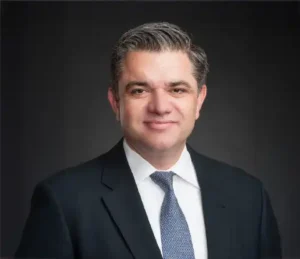Pioneer Shoulder Surgeon is an Expert in Robot Technology
Washington Health is the first hospital in northern California to offer the new Mako SmartRobotics™ device for shoulder joint replacement surgery, using the same technology that has transformed knee and hip joint replacement.
World-renowned orthopedic surgeon John Costouros, MD, of Washington Health’s Institute for Joint Restoration and Research, is an expert in total shoulder joint replacement. He introduced the reverse total shoulder procedure in the United States more than 20 years ago. He has recently been certified on the Mako SmartRobotics™ device, a robot that guides precision and preparation of the shoulder joint for a more custom fit during total shoulder joint replacement.
Washington Health is among only six medical centers in the country to offer the new robotic-assisted surgery. “Shoulder replacement is the fastest growing area of joint surgery,” says Dr. Costouros, who is certified by the American Board of Orthopedic Surgery, and trained at Stanford University, the University of California at San Francisco, and Harvard Medical School at Massachusetts General Hospital.
“What we learned from hip and knee replacements we’re now adapting to the shoulder, which is inherently a more complicated joint,” he adds.
Dr. Costouros underwent training in shoulder replacement technology in Europe, where the reverse total shoulder replacement technology was first developed prior to 2004 FDA approval in the United States. “The shoulder is the most complicated joint in the body, with a very complex anatomy and a dynamic interplay between bones and soft tissues, enabling the widest range of motion of any joint,” Dr. Costouros explains. “The complexity of the shoulder joint makes it ideal for use of this new technology.”
Advanced Technology, Better for Patients
Using a 3D CT scan, along with robotic and haptic (touch feedback) technology, Dr. Costouros utilizes the Mako SmartRobotics device to make the joint fit within 1 millimeter of accuracy and precision, better than the human eye. Assisting in reverse shoulder joint replacement, the robotic device aids surgeons by guiding their hand in the operating room based on the surgical plan developed by the doctor prior to surgery.
The new technology’s software works with the scan of a patient’s shoulder to help the surgeon map how and where to prepare the bony surfaces to make the synthetic joint fit precisely to each person’s unique anatomy. The new robotic technology improves outcomes, surgical accuracy, longevity of the implant, and patient satisfaction; while also preserving bone and reducing pain.
“Before robots, we used precision tools, guides, augmented reality goggles, and other high-tech devices to execute the surgical plan,” notes Dr. Costouros, adding that the most important skill is always the surgeon’s experienced hand. “But now we have robots and haptic assistance to guide us even further.”
Rotator Cuff Repairs, Arthritis, Fractures
Additionally, this robot-assisted surgery will help those suffering from rotator cuff tear arthropathy, non-repairable rotator cuff tear with arthritis, complex fractures, and prior failed joint replacements.
“We’re moving forward in an age of precision medicine and transformational technology. It will only continue to improve outcomes and increase longevity of the artificial joint as the number of patients undergoing shoulder replacement procedures continues to grow.”
Dr. Costouros continues, “I’m privileged to work at one of the best sites in the world to offer this surgery. We’re contributing to developing this technology further and improving the patient experience for the future so that we can continue to relieve pain and suffering in many patients and improve their quality of life into the future.” For more information about Washington Health’s joint replacement program and Dr. Costouros, visit www.californiashoulder.com and www.washingtonhealth.com/IJRR.


